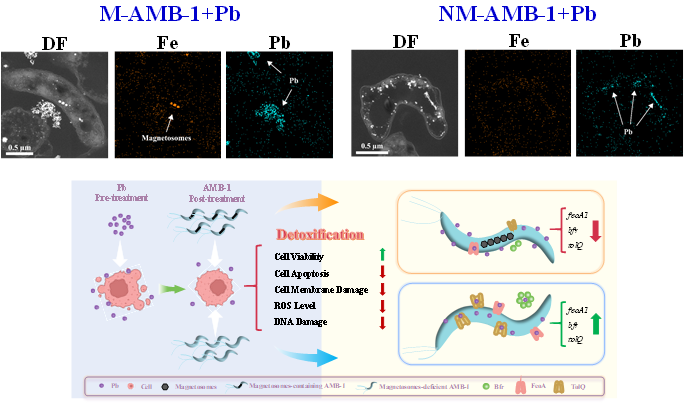
Recently, a research team led by Prof. XU An from the Hefei Institutes of Physical Science of the Chinese Academy of Sciences, has discovered that magnetotactic bacteria (MTB) — tiny microorganisms that can sense and move along magnetic fields — have remarkable abilities to resist and detoxify lead (Pb), one of the most toxic heavy metals in the environment.
The research results were published in Journal of Environmental Sciences.
Lead, a highly toxic heavy metal pollutant with a long biological half-life and environmental persistence, has posed serious threats to global health. However, efficient and safe detoxification methods for Pb poisoning remain lacking. Studies have shown that MTB have efficient heavy metal recovery ability and favorable biosafety.
In this study, the researchers compared two types of Magnetospirillum magneticum bacteria — one with magnetosomes (tiny magnetic particles inside the cells) and one without.
The results showed that both could significantly detoxify Pb(Ⅱ)-induced various adverse effects even after 6 h of Pb(Ⅱ) pre-treatment, including cell damage, oxidative stress, and DNA injury.
Interestingly, the team discovered that the two types of bacteria used different strategies to handle lead. The magnetosome-containing bacteria mainly adsorbed lead on their cell surfaces, trapping the metal externally. The bacteria without magnetosomes, on the other hand, absorbed lead into their cells, likely through pathways usually used for transporting iron.
These differences seem to be linked to the iron content in the cells — a higher iron level may help block lead from entering the bacteria.
These findings might not only offer novel intervention strategies for Pb(Ⅱ) poisoning, but also expand the application of MTB in the field of environmental health, according to the team.

Magnetotactic bacteria antagonized lead toxicity through distinct enrichment mechanisms in magnetosome-containing/deficient bacteria. (Image by LIU Yun)